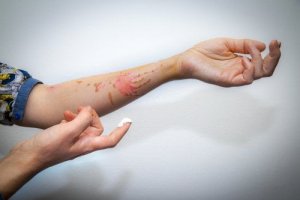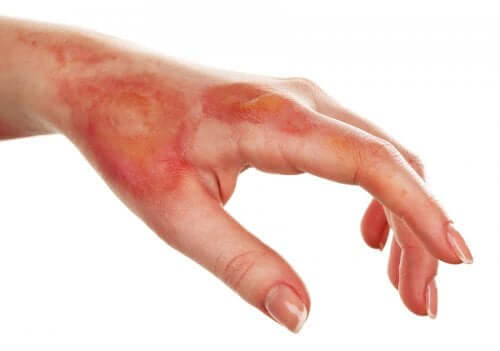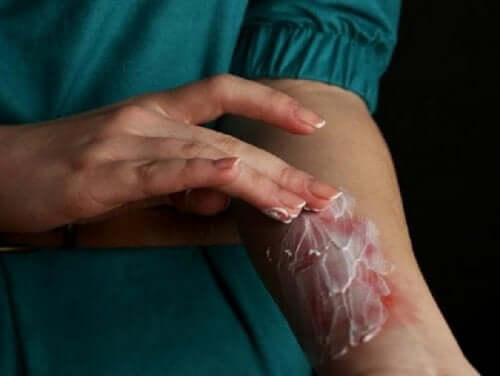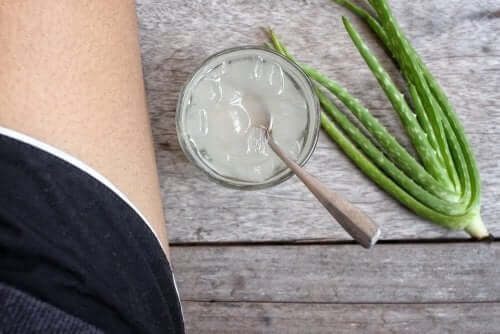How to Treat a Superficial Burn

Nearly every person has experienced a superficial burn. For the most part, these are the result of a household accident, mainly in the kitchen.
Also, there are other burns such as those that happen due to overexposure to the sun without protection. They may also come from contact with hot irons, spillage of a cup of coffee, or perhaps accidentally touching an exhaust pipe. These light burns are usually easy to treat at home and don’t require a visit to the emergency room.
However, you should learn to differentiate superficial burns (first-degree) from deeper ones (third-degree). When it comes to superficial burns, there are many topical remedies you can use to soothe your skin and the pain it causes.
Different Degrees of Burns

Doctors classify burn by their degree of damage to the skin layers. Thus, there are first, second, and third-degree burns. The treatment will vary depending on the characteristics of a burn, concerning these categories.
- Most domestic burns fall in the first-degree category. What this means is that the injury is superficial and there’s only damage in the outer layer of the skin.
- Also, some burns may be categorized as a second-degree. On this, the damage reaches not only the first layer of the skin or epidermis but also the second layer or dermis.
- Finally, a third-degree burn reaches the layer of fat under the dermis. Therefore, it’s much more severe. This is because it may damage the nerves and lead to permanent numbness. Generally, these burns are the result of major fires or electrical and chemicals exposure.
Superficial burns mainly cause redness and pain. Additionally, the skin may also look swollen and there may be blisters in the affected parts of the body.
Fortunately, there are many forms of basic treatment you can do at home when a minor burn occurs by using topical remedies to soothe any burning, pain, and swelling.
You may be interested: Marigold and What it Can Do for Your Health
First Aid for a Superficial Burn

The first thing to do if you get a superficial burn is to cool down the skin. Coldwater is the fastest way to do so. However, you mustn’t use ice. This is because it could do even more damage to the skin. Ideally, maintain the injured skin under running water for a few minutes.
Once you confirm that a burn is superficial, gently clean the area with soap and water. Don’t pop the blisters if there are any. This is because an open blister can easily become infected and it could worsen the injury. In contrast, don’t cover the wound with anything that may leave fibers behind, as these easily stick to the burn.
You may have heard of certain home remedies such as applying mustard, butter, toothpaste, oil or egg whites. This is not a good idea. Instead, there are some specially designed ointments you can use, they’re available in your local pharmacy.
If you can’t stand the pain then you may use over-the-counter pain relievers such as paracetamol or ibuprofen. Ordinarily, you can effectively control the pain and subsequent symptoms by attending to the burn promptly.
Here are some of the best natural remedies.
Aloe Vera Gel

This plant has many wonderful properties. Among them, it’s great for relieving irritation, pain, and swelling. Also, it has antibacterial qualities and it’s a natural, safe and effective option to relieve discomfort caused by superficial burns.
Marigold Cream
Also known as calendula cream, this is another highly effective way to relieve the irritation and swelling caused by a burn. Note that it shouldn’t contain any artificial colors or scents.
You may be interested: 6 Medicinal Uses for Vaseline that You’ll Want to Know
Honey
Among studies of quick and easy treatments to soothe mild burns, scientists found that honey has antibacterial and anti-inflammatory properties that promote healing.
An update to a study in 2014, examining the results of more than a dozen previous studies, revealed that superficial burns healed faster when covered with gauze and a dash of honey. Actually, the healing happens faster than in those wounds treated only with antibiotic ointments and other dressings. A separate report published earlier found similar results.
Healing Creams for a Superficial Burn
Many types of healing skin creams out there are also good natural remedies. These ointments don’t produce further discomfort. Instead, they offer immediate relief to the skin and help regenerate it.
Generally, these types of creams are made with essential oils and other ingredients that have antioxidant, anti-inflammatory, and skin regeneration properties. Their effect is very positive on the dermis.
Finally, keep in mind that if you think you’re dealing with a more serious burn then you should go to an emergency room. A doctor must assess the damage so they can indicate the most appropriate treatment for it.
All cited sources were thoroughly reviewed by our team to ensure their quality, reliability, currency, and validity. The bibliography of this article was considered reliable and of academic or scientific accuracy.
- Ana Peñalba Citores, Rafael Marañón Pardillo .Sección de Urgencias Pediátricas. Hospital Universitario Gregorio Marañón. Madrid. Tratamiento de las quemaduras en urgencias. Extraído de: https://www.aeped.es/sites/default/files/documentos/tratamiento_de_las_quemaduras_en_urgencias.pdf
- Miguel Aladro Castañeda, Sara Díez González. Revisión del tratamiento de las quemaduras. Extraído de: https://www.seapaonline.org/UserFiles/File/Revistas/invierno%202013/Revision_del_tratamiento_de_las_quemaduras.pdf
This text is provided for informational purposes only and does not replace consultation with a professional. If in doubt, consult your specialist.








